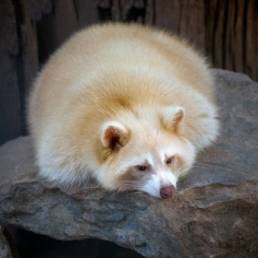Albi the Albino Racoon
Albi is an Albino Racoon, that means he is the same as his cousins the Racoons except his colourings are different. He didn’t develop the distinctive black stripes, but don’t tell him he’s not a racoon!
Science tell us its genetic mutation, but we prefer to call him a special racoon. Colour doesn’t matter and he has as much fun as all the other racoons. However he is very rare and if you meet him you’ll know he kind of realises he a pretty big deal.

Description
The adult raccoon is a medium-sized mammal and the largest of the Procyonidae family. It averages 24 to 38 inches in length and can weigh between 14 to 23 lbs., or more, depending upon habitat and available food. The male raccoon, or boar, is slightly larger than the female, also referred to as sow. The young are called kits
Albi doesn’t have the mask of black fur that usually covers the eyes. This might mean his nocturnal or night vision, isn’t as good. His fur is still mostly the dense underfur to insulate him against the cold. Because its hind legs are longer than the front legs, a raccoon often appears hunched when they walk or run. The five toes on his front paws are extremely dexterous, functioning essentially as five little fingers which allow it to grasp and manipulate food it finds in the wild as well as a variety of other objects, including doorknobs, jars, and latches. A raccoon’s most heightened sense is its sense of touch. It has very sensitive front paws and this sensitivity increases underwater. When able, a raccoon will examine objects in water.
Diet
The raccoon is an omnivorous and opportunistic eater, with its diet determined heavily by its environment. Common foods include fruits, plants, nuts, berries, insects, rodents, frogs, eggs, and crayfish. In urban environments, the animal often sifts through garbage for food. The majority of its diet consists of invertebrates and plant foods
Habitat
The raccoon is native to North America and can be found throughout the United States, except for parts of the Rocky Mountains, and southwestern states like Nevada, Utah, and Arizona. It can also be found in parts of Canada, Mexico and the northern-most regions of South America.
Originally raccoons lived in the tropics where they could be found foraging along riverbanks. Over time they moved north up the continent, successfully adapting to new territories and expanding their diet. Traditionally, they live in tree cavities or burrows emerging at dusk to hunt frogs and crustaceans while keeping an eye out for predators such as coyotes and foxes. Barns have aided their northern migration, offering refuge from cold northern winters, and now, raccoons have been found as far north as Alaska. The species originally kept to the deciduous and mixed forests of North America, but its impressive ability to adapt has enabled the animal to move into a wide range of habitats, from mountainous terrains to large cities. The first urban sighting was in Cincinnati during the 1920s. Raccoon populations do very well in urban areas, primarily due to hunting and trapping restrictions, a general lack of predators, and an abundance of available human food. The size of a raccoon’s home range varies depending on habitat and food supply. In urban areas, its home range generally spans about one mile.
Did You Know?
- The raccoon’s scientific name, Procyon lotor is neo-Latin and translates to “before-dog washer.”
- Christopher Columbus is the first individual we know of to have written about the species.
- The raccoon’s taxonomy has been debated over time. Carl Linnaeus placed the raccoon in the Ursus genus—first as Ursus cauda elongate (“long-tailed bear”) and then as Ursus lotor (“washer bear”). In 1780, Gottlieb Congrad Christian Storr created a separate genus for the species, Procyon, meaning doglike.
- The English word “raccoon” is an adaptation of a native Powhatan word meaning “animal that scratches with its hands.”
- In the winter, the raccoon does not hibernate, but can sleep in its den for weeks.
- A raccoon can run at speeds of up to 15 miles per hour.
- The raccoon is a good swimmer and can stay in water for several hours.
- The species makes a variety of vocalizations including hisses, whistles, screams, growls and snarls.
- A series of studies in the mid-to-late-twentieth century show that a raccoon can remember solutions to tasks for up to 3 years.
Get Involved
Albi and His Friends Have Great Appetites
Why Not help us Feed Albi and his friends, each year at the Garden our animals are fed and cared for by volunteers supported by the public. So if your would like to help us care for our animals why not donate today and then come join us for feeding time and meet your animals in person.
